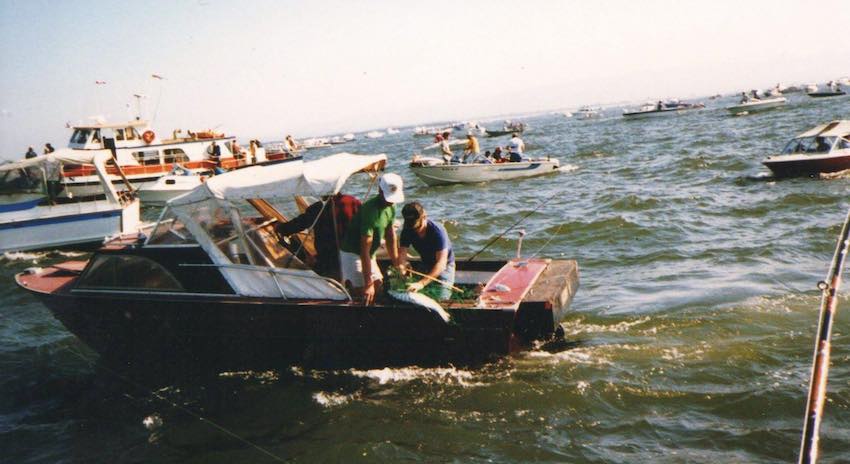forum
library
tutorial
contact

Buoy 10 Opens as Huge Coho Return Expected,
162% of Average
by Staff
Columbia Basin Bulletin, August 2, 2019
|
the film forum library tutorial contact |

|
Buoy 10 Opens as Huge Coho Return Expected,
by Staff
|
 Fall seasons and regulations were set for some treaty fishing and non-treaty commercial fishing in the lower Columbia River Basin, with the Oregon-Washington Columbia River Compact’s approval on Tuesday.
Fall seasons and regulations were set for some treaty fishing and non-treaty commercial fishing in the lower Columbia River Basin, with the Oregon-Washington Columbia River Compact’s approval on Tuesday.
In addition, the popular Buoy 10 salmon fishery at the mouth of the Columbia River opened Aug. 1 for fall Chinook and hatchery coho. While Chinook fishing will be restricted beginning Aug. 21, the department says anglers can expect good coho fishing through at least mid-September.
The forecast for the 2019 fall Chinook adult return to the Columbia River totals 349,700 fish, which would be greater than the 2018 actual return of 293,424 adults and 47 percent of the 2009-2018 average return of 737,720 adults.
Bonneville Dam passage is expected to total 228,600 fall Chinook adults. Passage is typically 50 percent complete by Sept. 9.
The forecast for the steelhead return to Bonneville Dam totals 118,200 fish, including 40,450 unclipped fish. The number of steelhead that pass July through October is expected to be 46 percent of the 10-year average, while the number of fish that pass Bonneville August through October -- fish that primarily return to Idaho waters -- is expected to be just 24 percent of the 10-year average.
The 2019 coho forecast for Columbia River is a return of 611,300 adults, which includes 388,000 early season stock and 223,300 late season stock. The forecast is 162 percent of the 10-year average of 377,900 fish. Bonneville passage is expected to total 180,300 adult coho, representing 64 percent of the forecast ocean abundance of coho.
A 2018-2027 Management Agreement provides specific fishery guidelines with allowable Endangered Species Act impact rates that are based on preseason forecasts. The allowable impact rate for combined treaty Indian and non-treaty fisheries is 31 percent, with 23 percent allocated to treaty Indian fisheries and 8.25 percent for non-treaty fisheries.
This year, however, Oregon and Washington have opted to manage non-treaty fisheries conservatively, and a harvest rate of just 6.58 percent is expected. Additional fishing opportunities are planned if fish returns meet or exceed expectations.
The impact rates are within Endangered Species Act limitations set for 2019, based on fish return forecasts. The "exploitation rate" limitation is 38 percent for fall Chinook and 23 percent for combined ocean and Columbia River Coho fisheries.
Expected harvest in Select Area fishing sites include 88,700 coho and 1,600 fall Chinook. Lower River hatchery fall Chinook will also be available for harvest in all sites. Catch expectations for coho and Chinook are 168 percent and 24 percent of respective 10-year averages.
The season structure approved this week for Treaty fisheries include Zone 6, platform and hook-and-line fishing, 12:01 a.m. Aug. 1 through 6 p.m. Dec. 31.
In Yakama Nation commercial fishing, Zone 6 tributaries, 12:01 a.m. Aug. 1 through 6 p.m. Dec. 31, and only during days and times opened under Yakama Nation tribal subsistence regulations.
Commercial platform and hook-and-line fishing downstream of Bonneville, the season was set for 12:01 a.m. Aug. 1 through 11:59 p.m. Oct. 31.
Regulations and season structure in the non-treaty fall gillnet fisheries of Blind/Knappa Slough, Tongue Point/South Channel and Youngs Bay are similar to recent years. Deep River regulations have been modified to provide additional opportunity to target late season Coho.
The Deep River season structure raised some consternation among the Columbia River Compact panel this week, with one panel member calling it "Byzantine" and possibly difficult to understand, but the season structure was approved. It was explained that the intent of the more elaborate season structure is to optimize fishing opportunity during the peak of the Coho run.
The Deep River fishery will be open Monday and Wednesday nights Aug. 26-29; Monday, Tuesday, Wednesday, Thursday and Friday night, Sept. 2-21; Monday, Tuesday, Wednesday and Thursday nights, Sept. 23-27; Monday and Wednesday nights, Oct. 7-18; Monday, Tuesday, Wednesday, Thursday and Friday nights, Oct. 21-Nov. 16; Monday, Tuesday, Wednesay and Thursday nights, Nov. 18-29.
The Deep River open hours are are 7 p.m.-7 a.m., Aug 26-29; 6 p.m.- 9 a.m Sept. 2 to Nov. 2, and 5 p.m.-8 a.m. through the remainder of the season.
The Blind Slough/Knappa Slough fishery season was set for Monday and Wednesday nights, Aug. 26-29, and Monday Tuesday, Wednesday and Thursday nights, Sept. 2 through Oct. 25. Open hours are 7 p.m.-7 a.m. through Sept. 6 and 6 p.m.-10 a.m. through the remainder the season.
The Tongue Point/South Channel fishery season is Monday and Wednesday nights, Aug. 26-29, and Monday, Tuesday, Wednesday and Thursday nights, Sept. 6 through Oct. 25. Open hours are 7 p.m.-7 a.m. through Sept. 6 and 4 p.m.-10 a.m. through the remainder of the season.
At the Youngs Bay fishery, the season was set for 7 a.m. Tuesday to 7 a.m. Thursday, weekly from Aug. 6-22; and Monday and Wednesday nights, Aug. 26-29, with open hours of 7 p.m.-7 a.m.; and 7 p.m. Monday, Sept. 2 through noon, Oct. 31.
learn more on topics covered in the film
see the video
read the script
learn the songs
discussion forum
